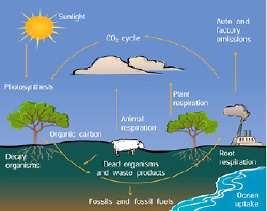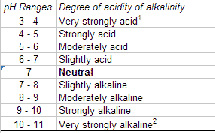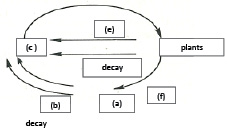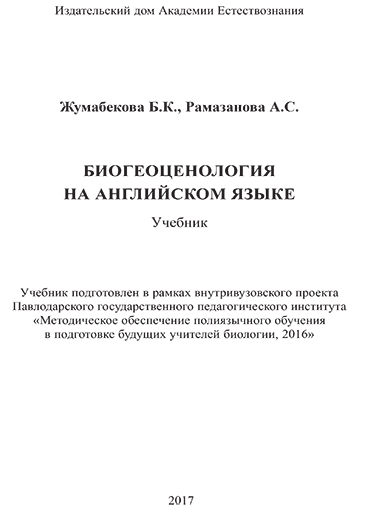
Научная электронная библиотека
Монографии, изданные в издательстве Российской Академии Естествознания
Chapter 6. ATMOSPHERE AS A PART OF BIOGEOCENOSIS
|
Essential targets: By the end of this chapter you should be able to: discuss about atmosphere, its features, components; discuss the significant of atmosphere in the Earth’s ecosystem. |
Read the text. Divide the text into three parts. Make the flowcharts for each part. Explain your results / Мәтінді оқып шығыңдар. Мәтінді үш бөлікке бөліңдер. Әрбір бөлік үшін блок-сызба құрастырыңдар. өз нәтижелеріңді түсіндіріңдер / Прочитайте текст. Разделите текст на три части. Составьте блок-схему для каждой части. Объясните свои результаты.
The atmosphere of Earth is the layer of gases, commonly known as air that surrounds the planet Earth and is retained by Earth’s gravity. The atmosphere protects life on Earth by absorbing ultraviolet solar radiation, warming the surface through heat retention (greenhouse effect), and reducing temperature extremes between day and night (the diurnal temperature variation) [1].
By volume, dry air contains 78.09% nitrogen, 20.95% oxygen, 0.93% argon, 0.039% carbon dioxide, and small amounts of inert gases. Oxygen is created during primary production (by plants) and carbon dioxide is released through respiration of living organisms and as result of many other processes. Air also contains a variable amount of water vapor, on average around 1% at sea level, and 0.4% over the entire atmosphere. Air content and atmospheric pressure vary at different layers, and air suitable for use in photosynthesis by terrestrial plants and breathing of terrestrial animals is found only in Earth’s troposphere and in artificial atmospheres [1]. Excluding the exosphere, Earth has four primary layers, which are the troposphere, stratosphere, mesosphere, and thermosphere [2]. The ozone layer is contained within the stratosphere. The ozone layer or ozone shield is a region of Earth’s stratosphere that absorbs most of the Sun’s ultraviolet (UV) radiation. It contains high concentrations of ozone (O3) in relation to other parts of the atmosphere [3].
The atmosphere has a mass of about 5.15×1018 kg, three quarters of which is within about 11 km (6.8 mi; 36,000 ft) of the surface. The atmosphere becomes thinner and thinner with increasing altitude, with no definite boundary between the atmosphere and outer space. The Kármán line, at 100 km (62 mi), or 1.57% of Earth’s radius, is often used as the border between the atmosphere and outer space. Atmospheric effects become noticeable during atmospheric reentry of spacecraft at an altitude of around 120 km (75 mi). Several layers can be distinguished in the atmosphere, based on characteristics such as temperature and composition [1].
Organisms, which need oxygen for their existence, are called aerobic, and organisms, which live in non-oxygen (anoxic) space are called anaerobic [4].
Atmospheric circulation is very often connected to the activation of different species of animals, for example, the massive increase in reproduction of insects. Wind has a great importance in plant life. Anemophilous plants are pollinated by wind-distributed pollens. Wind also takes part in spreading seeds and fruits of plants. Spreading of many species geographically and their location in a biotope are also connected to wind [5].
Glossary of essential terms / Негізгі терминдер глоссарийі / Глоссарий основных терминов
|
№ |
English term |
Kazakh equivalent |
Russian equivalent |
|
1 |
amount |
саны |
количество |
|
2 |
carbon dioxide |
көмірқышқыл газы |
углекислый газ |
|
3 |
dry air |
құрғақ ауа |
сухой воздух |
|
4 |
existence |
тіршілік |
существование |
|
5 |
fruit |
жеміс |
плод |
|
6 |
gravity |
тартылыс |
притяжение |
|
7 |
greenhouse effect |
жылыжай әсері |
парниковый эффект |
|
8 |
pollen |
тозаң |
пыльца |
|
9 |
pollinated |
тозаңдандыру |
опылять |
|
10 |
pressure |
қысым |
давление |
|
11 |
seed |
дән |
семя |
|
12 |
spacecraft |
ғарыш аппараты |
космический аппарат |
|
13 |
spreading |
таралу |
распространение |
|
14 |
vapor |
буы |
пар |
|
15 |
volume |
көлем |
объем |
|
16 |
wind |
жел |
ветер |
|
Key phrases and sentences / Түйінді сөздер мен сөйлемдер / Ключевые фразы и предложения 1. The atmosphere is the … / Атмосфера дегеніміз … / Атмосфера – это … 2. The atmosphere is very important for Earth’s life because … / Атмосфера жер бетіндегі тіршілік үшін маңызы үлкен, себебі ... / Атмосфера имеет большое значение для жизни на Земле, т.к. ... 3. The atmosphere contains different kinds of … / Атмосфера ... әралуан түрлерін қамтиды / Атмосфера содержит различные виды …. 4. The atmosphere is a component of the … ecosystem… / Атмосфера … экожүйенің компоненті болып табылады / Атмосфера – это компонент … экосистемы. |
|
Questions: What are the components of the atmosphere of Earth? What roles do the atmosphere in ecosystem? What is ozone layer? Why is the ozone layer important for Earth’s life? How does oxygen exist in the atmosphere? What role do green plans have within the oxygen cycle? |
I. Look at the picture and explain the Carbonic Cycle. Answer the questions below / Суретті қарап шығыңдар және табиғаттағы көміртегі айналымын түсіндіріңдер. Төменде келтірілген сұрақтарға жауап беріңдер / Рассмотрите рисунок и объясните круговорот углерода в природе. Ответьте на приведенные ниже вопросы.

Figure 5. Carbonic Cycle [6]
1. How does carbon exist in the atmosphere?
2. How are fossil fuels created? Explain.
3. Describe the ways that carbon enters the atmosphere.
4. How are the oceans involved in the carbon cycle?
5. How is the temperature of the Earth partly controlled by carbon?
6. What role do forests have within the carbon cycle?
7. What role do factories have within the carbon cycle?
II. Draw the oxygen cycle. Make the questions on the topic “Oxygen cycle” / Табиғаттағы көміртегі айналымының сызбасын суретке салыңдар. «Табиғаттағы оттегі айналымы» тақырыбына сұрақтар құрстырыңдар / Нарисуйте схему круговорота кислорода в природе. Составьте вопросы на тему “Круговорот кислорода в природе”.
III. Give the samples of aerobic and anaerobic organisms. Why do aerobic organisms need oxygen? How do anaerobic organisms respire? / Аэробы және анаэробты ағзаларға мысал келтіріңдар. Не себептен аэробы ағзаларға оттегі қажет? Анаэробты ағзалар қалай тыныс алады? / Приведите примеры аэробных и анаэробных организмов. Почему аэробные организмы нуждаются в кислороде? Как анаэробные организмы дышат?
IV. Read the given text and write out the positive and negative significances of a greenhouse gas for the Earth’ life. Discuss your marks results in group and make a conclusion how human activities cause a global warming / Мəтінді оқып шығыңдар және жердегі тіршілік үшін жылыжайлық газдардың оң және теріс маңызын теріп жазып алыңдар. Өз нәтижелеріңді топта талқылаңдар және жаһандық жылынуға адам әрекеті қалай әсер ететініне байланысты қорытынды жасаңдар / Прочитайте текст и выпишите положительные и отрицательные значения парниковых газов для жизни на Земле. Обсудите результаты вашей оценки в группе и составьте вывод, как деятельность человека вызывает глобальное потепление.
A greenhouse gas (sometimes abbreviated GHG) is a gas in an atmosphere that absorbs and emits radiation within the thermal infrared range. This process is the fundamental cause of the greenhouse effect. The primary greenhouse gases in Earth’s atmosphere are water vapor, carbon dioxide, methane, nitrous oxide, and ozone. Without greenhouse gases, the average temperature of Earth’s surface would be about −18 °C (0 °F), rather than present average of 15 °C (59 °F). In the Solar System, the atmospheres of Venus, Mars and Titan also contain gases that cause a greenhouse effect.
Human activities since the beginning of the Industrial Revolution (taken as the year 1750) have produced a 40% increase in the atmospheric concentration of carbon dioxide, from 280 ppm in 1750 to 400 ppm in 2015. This increase has occurred despite the uptake of a large portion of the emissions by various natural «sinks» involved in the carbon cycle. Anthropogenic carbon dioxide (CO2) emissions (i.e. emissions produced by human activities) come from combustion of carbon-based fuels, principally coal, oil, and natural gas, along with deforestation, soil erosion and animal agriculture.
It has been estimated that if greenhouse gas emissions continue at the present rate, Earth’s surface temperature could exceed historical values as early as 2047, with potentially harmful effects on ecosystems, biodiversity and the livelihoods of people worldwide [7].
V. How do you think what would happen to the Earth without an atmosphere? Write a short essay / Қалай ойлайсыңдар, атмосферасыз Жер қандай болар еді? Қысқа эссе жазыңдар / Как вы думаете, что случилось бы на Земле без атмосферы? Напишите короткое эссе.
|
SUMMARY The atmosphere is the air layer of Earth. The atmosphere protects life on Earth by absorbing ultraviolet solar radiation, warming the surface through heat retention (greenhouse effect), and reducing temperature extremes between day and night (the diurnal temperature variation). Air contains nitrogen, oxygen, argon, carbon dioxide, and small amounts of other gases. The atmosphere has following layers: the troposphere, stratosphere with ozone layer, mesosphere, thermosphere, exosphere. |
 Topics for essay:
Topics for essay:
1. The history of the formation of the atmosphere.
2. Troposphere is the lowest portion of Earth’s atmosphere.
3. Stratosphere is the second major layer of Earth’s atmosphere.
4. Mesosphere is the layer of the Earth’s atmosphere.
5. Thermosphere is the layer of the Earth’s atmosphere.
6. Ultraviolet solar radiation.
7. Exosphere is the outer layer of the Earth’s atmosphere
8. Ionosphere is a region of Earth’s upper atmosphere.
9. Atmospheric pollution.
10. Aerobic and anaerobic organisms (examples).
 References:
References:
1. BBC // http://www.bbc.co.uk/science/earth/atmosphere_and_climate/atmosphere
2. Atmosphere of Earth // http://haseshailesh1.blogspot.com/
3. Ozone layer // https://en.wikipedia.org/wiki/Ozone_layer
4. BBC // http://www.bbc.co.uk/education/guides/zm6rd2p/revision/2
5. Atmospheric circulation // https://en.wikipedia.org/wiki/Atmospheric_circulation
6. http://pichispheal.weebly.com/crash-course-hydrologic-and-carbonic-cycles.html
7. https://en.wikipedia.org/wiki/Greenhouse_gas
LABORATORY WORK 2
The theme: SOIL SURVEY STANDARD TEST METHOD pH: 1:5 SOIL: WATER SUSPENSION.
The aim: To learn how to quantify the pH of soil. To consider the factors that affect soil pH in different environments.
Materials and equipment: Samples of soil. pH meter and pH electrode. Mechanical stirrer. Reagents:
pH 4.01 Buffer (25 °C) – Dry potassium hydrogen phthalate AR (KHC8H4O4) for 2 hours at 105 °C and cool in a desiccator before the initial weighing. Dissolve 10.21 g in deionised water and make to 1 L in a volumetric flask. The solution is stable for 6 weeks. Discard if fungus appears. Record the date the buffer was made up on the container.
pH 6.86 Buffer (25 °C) – Dry potassium dihydrogen phosphate (KH2PO4) and disodium hydrogen phosphate (Na2HPO4) for 2 hours at 105 °C and cool in a desiccator before the initial weighing. Dissolve 3.38 g of KH2PO4 and 3.35 g of Na2HPO4 in about 800 mL of deionised water and make up to 1 L in a volumetric flask.
pH 9.18 Buffer (25 °C) – Dissolve 19.069 g of sodium tetraborate (Na2B4O7.10H2O) in about 800 mL of deionised water and make to 1 L in a volumetric flask. This buffer should be protected from absorption of atmospheric CO2. Commercially available buffer solutions can be used in place of the above.
Background Information
This is the activity of the negative log of the hydrogen ion in a suspension of 1:5 soil:water. It is the de facto standard pH measurement for most soil test interpretations. The pH measured in 1:5 soil:water suspension is sensitive to seasonal variations in the pH of soil solutions.
The pH is determined on a 1:5 soil:deionised water suspension. Measurement of pH involves detection of the charge in potential of a silver/silver chloride combination electrode or glass electrode/reference electrode system using a pH or millivolt meter standardised against known buffer solutions.
It is important to remember that soil pH is a measure of the H+ activity of the soil solution. It is not a measure of the total acidity of the soil. The amount of H+ in the soil solution is a function of the proportion of soil cation exchange capacity that is satisfied by H+ ions, not the total amount of exchangeable H+ in a given soil. Table 1 shows the expected pH range for most agricultural soils.
pH ranges and degrees of acidity of alkalinity for mineral soils



Procedure:
1. Prepare a 1:5 soil:water suspension. Weigh 10 g air-dry soil (<2 mm) into a bottle and add 50 mL deionised water. (Other amounts can be used e.g. 20 g:100 mL provided the 1:5 ratio is maintained.) Mechanically shake for 1 hour at 15 rpm. (See Note 1.)
2. Calibrate the pH meter according to manufacturer’s instructions using the buffer at pH 6.86 and either the 4.0 or 9.18 buffer depending on the expected values for the soils. Stir these solutions with a mechanical stirrer during measurement. Thoroughly wash the electrode between measurements with deionised water. (See Note 2.)
3. Immerse the electrode into the soil suspension. Record the pH value obtained when the equilibrium is reached while stirring with a mechanical stirrer. (See Note 3.)
4. Use the Table 1 and determine the degree of acidity of alkalinity for given samples of soils.
5. Make the conclusion of factors that affect soil pH.
NOTES
1. When required the pH can be determined on the same soil suspension prepared for the measurement of electrical conductivity. Because there is leakage of KCl from the pH reference electrode, the electrical conductivity must be measured first.
2. Periodically confirm there is adequate leakage of KCl from the electrode otherwise inaccurate readings may be obtained on soil suspensions. This is achieved by placing the reference electrode in dilute AgNO3 solution and observing that a precipitate of AgCl forms.
3. Equilibration time will vary according to age of electrode and sample buffering capacity
References:
Soil pH: 1:5 Soil:Water Suspension Test // http://www.environment.nsw.gov.au/
resources/soils/testmethods/phw.pdf
pH Capacity and Intensity// http://passel.unl.edu/pages/informationmodule.php?
idinformationmodule=1130447041&topicorder=4&maxto=10
TOPICS FOR SEMINAR
Seminar 4
Chapter 4. Ecotope. Habitat. Ecological niche.
1. An ecotope as the part of a biogeocenosis.
2. An ecological niche: definition, features, samples.
3. Differences between “Habitat” and “Niche”
4. Classification of habitats.
Seminar 5
Chapter 5. Soil as a part of biogeocenosis.
A soil as an ecosystem.
Components of a soil.
The factors influencing the features of soil.
The types of soils.
Seminar 6
Chapter 6. Atmosphere as a part of biogeocenosis.
An atmosphere as a gas layer of Earth.
The ozone layer, its significant for Earth’s life.
A greenhouse gas, its significant for Earth’s life.
Impact of human activities on the atmosphere.
Recommended references:
1. Digdeeper // http://www.soils4kids.org/about
2. Centre for ecology & Hydrology // http://www.ceh.ac.uk/our-science/science-areas/biosphere-atmosphere-interactions
3. R. H. Whittaker, S. A. Levin and R. B. Root // 3. Niche, Habitat, and EcotopeR/ The American Naturalist. Vol. 107, No. 955 (May - Jun., 1973), pp. 321-338
TASKS FOR THE CONTROL WORK 2
1. Fill in the second column.
|
Term |
Definition |
|
Ecotope |
|
|
Ecological niche |
|
|
Habitat |
|
|
Soil’s fertility |
|
|
Humus |
|
|
Anemophilous plant |
|
|
Greenhouse gas |
|
|
Ozone layer |
2. Translate into English the following words: свойство, абиотический фактор, ландшафт, однородный, популяция, сообщество, болото, тропический лес, облесение, измерение, климат, глина, песок, ил, суглинок.
3. The diagram represents part of a simplified carbon cycle. Write the name of the organisms, substances or processes represented by the letters (a)-(f).

4. True or False.
|
True |
False |
|
|
Ecotope is the habitat component of a biogeocenosis. |
||
|
A habitat is the part of niche where a living thing makes its home |
||
|
A species may live in more than one niche in different stages of its life cycle. |
||
|
A habitat has a number of niches. |
||
|
Two species can occupy the same niche. |
||
|
The soil colloid has a powerful effect on development, fertility, and available moisture of soils. |
||
|
The more greenhouse gases you have in the atmosphere, the less heat stays on Earth. |
||
|
When plants die and decay, they bring carbon into soil. |
||
|
A soil pH is a measure of the total acidity of the soil. |
||
|
Values below 7 indicate acidity which increases as the number decreases, 1 being the most acidic. |
5. Make the short essay on the topic “Сauses of a global warming”.
